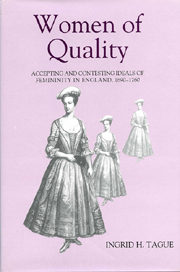Book contents
2 - The Attack on Fashionable Society
Published online by Cambridge University Press: 12 September 2012
Summary
In return for accepting a life of domestic bliss in a sentimental marriage, women were promised the pleasures of love, education, and household power. At the same time, they were constantly reminded that modern, fashionable society was undermining those values, destroying loving families by encouraging mercenary matches where the only consideration was money. According to many writers, however, such marriages represented only one aspect of the myriad dangers posed by modern life. The strong connection drawn between feminine modesty and chastity meant that a wide range of activities could be presented as violating this natural modesty and thus associated with a threat to chastity. Through this connotative chain, didactic authors sought to deal with new forms of leisure and entertainment that developed in the eighteenth century, creating widespread anxiety about women's crucial role in the new consumer society. The many fashionable activities attacked by these critics were seen to distract women from their natural domestic role and from their natural subservience to men. In response, didactic writers portrayed fashion and consumption as quintessentially feminine, yet also as threatening to feminine purity.
A concern with leisure and fashion was not in itself new. Richard Brathwait, for instance, had inveighed against women's attendance at plays and their slavish adherence to outlandish fashions in dress. Yet his criticism of these pastimes was based above all on their encouragement of sin, and such issues took up comparatively little room in his work. Other seventeenth-century writers, even Allestree, also touched only briefly on the question of fashionable activities and women's participation in them.
- Type
- Chapter
- Information
- Women of QualityAccepting and Contesting Ideals of Femininity in England, 1690–1760, pp. 49 - 71Publisher: Boydell & BrewerPrint publication year: 2002

